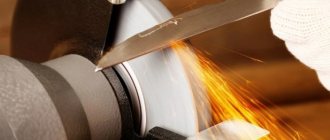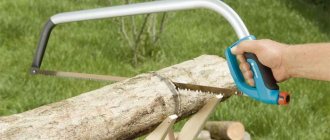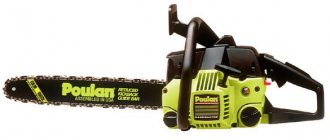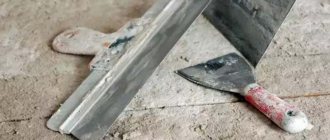Marking the cutting line
Side cutters are also used to apply notches to thin metal parts, marking cutting lines with a hacksaw or jigsaw.
This function of this tool significantly makes the work of a mechanic easier if he needs to make a precise cut, but simple construction scissors do not bite a sheet of metal, but only slide off it.
How is a miter saw used?
Basically, the end plate is used for cutting wooden parts: moldings, boards, baseboards, platbands, decorative strips. But when replacing the saw blade, you can cut plastic pipes or profiles, as well as thin metal parts.
The process of cutting parts with a miter saw is as follows:
- The workpiece is fixed on the bed at the desired angle to the cutting plane;
- The operator turns on the saw;
- Using the handle, the rotating disk is lowered onto the workpiece and makes a cut;
- The machine is turned off and the trimmed element is removed.
The scope of application of such an installation is very wide: from laying floors or covering walls with clapboards, to making doors, windows or other wooden structures, for which parts often have to be cut.
Simple operating principle
The design of side cutters is not much different from the design of pliers and wire cutters. The working components of this tool are connected by a special hinge.
A spring is placed between the handles. After the end of the compression period, it returns the handles to their original position. This happens immediately after biting an iron thread or cutting off a plastic edge.
Durability and comfort
Thanks to the indestructibility of the hinge joint, the master can press the handles of the side cutters as hard as he likes when processing metal workpieces. The strength of the cutting edges of the tool is ensured by the use of metals of increased hardness for their manufacture.
However, even the most durable side cutters must be very easy to use, which is necessarily taken into account during their manufacture.
Types of wire cutters
Depending on the type of working element, nippers are divided into the following types: • end • side • special.
end
The working element of end cutters intended for installation, electrical and construction work is made of special reinforced steel with subsequent chrome plating of the surface. The specially sharpened cutting edges of the wire cutter models differ in strength, so the choice of this type should correspond to the direction of the work being performed. The dialectical handles of end cutters can withstand significant operating voltage.
side cutters
The working element of the side cutters is located on the side of the head. For more efficient operation, for some models the cutting surface is additionally strengthened and hardened with high-frequency currents. There are models designed to cut different types of wire, ranging from thin aluminum to steel wire.
For this purpose, diagonal cutters are provided, which are equipped with inclined heads relative to the levers of the cutters. At the same time, the dynamic element - the hinge with the axis - can withstand daily monotonous loads. Diagonal wire cutters are capable of cutting wires made of steel 1.2 mm, mild steel up to 2.0 mm and copper wire up to 2.6 mm.
Professional side cutters are made of tool steel with multi-stage hardening and heat treatment. The handles of professional side cutters provide a comfortable grip and can withstand forces of up to 75 kg.
More detailed and complete information about side cutters is offered in this video.
Source: svouimirukami.ru
/brands/7/
Side cutters
is a cutting tool that is used in electrical installation work and other fields of activity. Their main purpose is to cut cables and wires, small metal elements, parts, and wires. Another name for side cutters is “side cutters.”
Side cutters: features and the right choice
Side cutters have such a feature as the location of the cutting edges (jaws) in the same plane as the handles. There are models of side cutters, where the jaws are located at a certain angle.
The area of application of side cutters is industry, construction and installation work. Most often they are used in cutting cables, wires and wires (small diameter), somewhat less often in cutting metal and plastic (small elements).
Side cutter design:
- serrated tips for pulling out TPG from cable and wire products;
- hardened sharp blades;
- handle locking element and their return spring;
- handles.
All working parts of the side cutter are connected to each other by a special lock with reinforced construction. The spring between the handles is characterized by plasticity and is designed to instantly return the jaws to their original position. It is important to pay attention to the fact that the closure of the edges of the side cutters must be very tight. The movement of the blades is light and smooth, which is ensured by a hinged joint. Moreover, this feature reduces the effort required to operate the side cutter.
The quality of side cutters and their reliability have a direct impact on the result of the work. Therefore, you need to be extremely careful when choosing and purchasing side cutters.
The first thing you need to know is that wire cutters can be either single-jointed or double-jointed (double gear lock). Double-hinged models provide more convenient work with minimal effort and labor costs. Side cutters with a leaf return spring automatically return the edges to their original position. If the proposed work involves electricity, it is important to pay attention to the dielectric properties of the tool.
Production of side cutters
The material used for the production of side cutters is high-strength metal. During the development of the tool and its manufacture, the safety of further operation and ease of use are carefully monitored. The handles of all models of side cutters have an ergonomic shape and an insulating winding that provides protection against electric shock.
Nippers are either insulated or insulating, which depends on the materials used in production. For example, insulating side cutters are those that are made entirely of insulating material and have metal cutting inserts. Insulated side cutters are tools with a special coating.
Side cutters must have high characteristics in terms of moisture resistance, oil resistance, and gasoline resistance. For this purpose, the design of the tool includes pobedit and carbide brazing, which slightly increases the cost of side cutters.
Before side cutters are released onto the market, the tools must pass all quality testing checks.
Using side cutters
It would seem that what could be difficult about using wire cutters? In fact, work using side cutters is characterized by certain requirements. For example, side-cut pliers should be positioned over the workpiece at a 90-degree angle. The tool should fit comfortably in the hand and be securely fixed in the hand. At the same time, you should not put excessive loads on the nippers.
The Planet Electric retail chain has a huge selection of different tools, which includes side cutters from leading manufacturers (HAUPA, Schneider Electric, DKC, KVT, etc.).
Source: www.elektro.ru
Modern dielectric cases
For this reason, the handles of side cutters are given ergonomic shapes. At the same time, they are covered with polymer attachments that prevent the hand from fogging in case of prolonged use of the tool. If it is used by the same master for a long time, then the soft handles gradually take on the shape of the owner’s palm.
Modern comfortable polymer materials used for the manufacture of dielectric handle covers do not leave bruises, dents and abrasions on the hands, which can appear with strong compression of old-style hard plastic insulating attachments.
Operational Capabilities
The capabilities of the device are determined by the size of the bolt cutter, or more precisely, the length of the handles, the design of the lever system and the shape of the blades. The operating principle and mechanical design of a bolt cutter has not changed for centuries, since the optimal design has been found. The use of high-quality steel for the handles allows us to somewhat reduce mechanical losses due to their bending and increase the useful force of the bolt cutter. The main increase in capabilities comes from improving the shape of the blades. Replacement attachments, which are supplied with both manual and hydraulic shears, are of the following types:
- Corner. The cutting plane is inclined at 24-35° to the axis of the rod. In the place where the rod is grabbed, a special plate is placed for a stop, which has the ability to slide. It can be secured with a pin after the bar is securely grasped. For ease of cutting in hard-to-reach places, the nozzle can be rotated 180° relative to the longitudinal axis.
- Flat. Specialized for cutting metal sheets. Equipped with a template to facilitate cutting strips of equal width.
- Centrifugal. The movement of the blades is symmetrical and equidistant from the surface of the rod. This is a standard attachment; bolt cutters with non-replaceable blades are made using the same design.
Universal nozzles are most effective when cutting reinforcement.
Lever operating principle
Thick nozzles on the handles guarantee one hundred percent protection against electric shock. Thanks to the application of lever force to the jaws, this tool allows you to cut fairly thick wires and insulated cables.
Usually, to perform a working stroke, the force of one hand is sufficient, but if necessary, the side cutters can be squeezed with both hands, which allows you to cut a wide-section energy line.
Pliers
This instrument comes from our childhood. A large encyclopedic dictionary of technical terms defines pliers as a hand-held metalworking and assembly tool equipped with pyramidal jaws of rectangular cross-section, used for gripping and bending small metal parts . From the definition it is clear that with pliers you can:
- hold an object (metal strip, washer, nail, electrical wire);
- bend a metal strip or wire.
That is, their main purpose is capture and manipulation. The tool can only hold and bend. It is not for nothing that among its many relatives - pliers - the tool is now extremely rare in store windows. Domestic pliers must comply with GOST 7336-93, according to which they are:
- With short (25–55 mm) or long (50–63 mm) jaws. By the way, the criterion for belonging to one type or another is not the length of the jaws, but the ratio of their linear dimensions to the dimensions of the clamping handles.
- With plain or insulated handles. The latter are manufactured in accordance with GOST 11563-94, which regulates the requirements for hand tools for performing work under high voltage.
Dimensions of manufactured instruments: 125–220 mm (total length).
Domestic tools are made from tool carbon steel U7A with volumetric hardening up to 45 HRC units. Decorative coating for protection against corrosion is applied in one of 3 ways:
- Chemical oxidation. The color of the coating is dark gray with a black tint.
- Chemical phosphating. The surface of the instrument is matte gray, in various tones (from light to dark gray).
- Chrome plating. This coating is the most durable and corrosion-resistant.
Main Applications
Side cutters are most often used
- Electricians;
- Assemblers of exhibition pavilions, street kiosks, country and park small architectural forms;
- Representatives of housing maintenance organizations, theater decorators, adjusters of communication systems, ventilation, and air conditioning.
Conventional and electrical side cutters
The set of functions for which a particular type of tool is intended is determined by its design features. Standard side cutters are used primarily for cutting plastic, iron, and wires.
Analogues equipped with thick dielectrics are most often used for laying cables in apartments and offices.
Purpose of the wire cutters
By their design, nippers are a universal tool for cutting metal and plastic products, working on the principle of a lever. They are capable of cutting wire, electrical wire, power cable, the thickness of which is 5–7 mm.
Wire cutters are used when installing and dismantling equipment and are widely in demand for electrical work. What criteria should be used when choosing this type of cutting tool, taking into account the scope of its application?
Cutting thin and thick wires
The speed and quality of cutting largely depends on the correct use of side cutters. To cut through thin wire or nylon thread, it is enough to place them at the very tips of the blades.
If there is a need to cut through a wide-section wire, then it is placed at the very base of the blades.
Assessing the condition of cutting edges
Any home craftsman or professional installer who is puzzled by how to choose side cutters must first evaluate the quality of the metal from which they are made.
- You should also examine the condition of the blades, especially for nicks, dents, and chips.
- Used tools may well end up in the retail chain, and this fact will be determined by examining the condition of the cutting edges.
How to choose a miter saw
Depending on the scope of application and load, it is necessary to take into account those parameters that may limit the master in his work. For example, more powerful miter saws will allow you to work longer without interruption and process larger workpieces.
We also recommend paying attention to elements that increase operator comfort. They provide not just comfort, but also greater precision and freedom in processing parts.
It will be easier for you to perform cross-cutting using a model with additional functions:
The cutting depth limiter simplifies the selection of grooves;
- Illumination of the cutting area and laser pointer allows you to accurately guide the saw blade even in poor lighting conditions in the workshop or on the street;
- The protective casing eliminates the possibility of injury to the operator. Models with automatically retractable casing are very convenient. For example, in Makita LH1201FL miter saws; BISON MASTER ZPT-210-1400 L
- The presence of additional clamps for fixing the workpiece on the table, clamps or expanding supports;
- The soft start mode extends the life of the engine and disk. This function is especially important when processing plastic profiles or pipes.
Also, when choosing a saw, you should make sure of the quality of the connection of all elements, the reliability of fixing the workpieces and the stable installation of the machine itself.
How to choose a hair dryer?
Checking the tightness of the blades
It is also important to check if there is a gap between the edges. The more tightly the blades fit together, the higher the effectiveness of the tool when cutting thin threads and wires. In some cases, professionals use a microscope to assess the tightness of the edges.
It allows you to see not only the gap between the blades, but also the smallest defects on the cutting edges, as well as defects in the protective coating that will become sources of corrosion.
Types of wire cutters
Based on the type of design of the working parts of the tool, there are 3 types of cutters: end cutters, side cutters and bolt cutters. All types of presented wire cutters can be purchased in the GSM kit online store. You can choose the kuachki yourself on the page https://gsm-komplekt.com/category/kusachki-bokorezy-/.
End
They are used during installation work, in construction, and when laying electrical networks. For the manufacture of the working element, reinforced steel with a chrome-plated surface is used. The cutting edges of this type of nippers are highly durable and are sharpened in a special way, which ensures high-quality performance of the work for which they are intended. The tool handles, made of dielectric, are resistant to high operating voltages.
Side cutters
The working element is at an angle relative to the tool head. The operating efficiency of the most powerful cutters of this type is ensured by additional reinforcement and hardening with high-frequency currents. Various models of products are available that can cut wires made of different metals and having different thicknesses - from aluminum to steel.
For diagonal wire cutters designed for cutting steel wires with a thickness of 1.2 mm, those made of mild steel - no more than 2.0 mm, and copper wires whose diameter does not exceed 2.6 mm, the heads are located at an angle to the surface of the handle. The hinge on the axis, which ensures the mobility of the working parts of the tool, is highly resistant to the constant impact of monotonous loads.
For the manufacture of professional side cutters, tool steel is used that undergoes heat treatment and multi-stage hardening. The handles of this type of nippers are comfortable to grip and can withstand impact forces of up to 75 kg.
Special nippers
One of the varieties of this type of cutting tool is bolt cutters. They are designed for cutting rods whose thickness does not exceed 12 mm. Representing a double lever in design and equipped with long handles, they first apply the applied force to an intermediate link that increases its value, and then to the cutting surface.
Another type of special cutters are products used for cutting small electronic parts. They have a mirror surface, open evenly, and are equipped with a device that removes static electricity. After watching the video presented to your attention, you can get acquainted with information about power cutters used for working with reinforcement.
Main types of side cutters
There are currently two types of this tool on the market:
- Single-hinged;
- Double-hinged.
Characteristics of bolt cutters
To select the correct equipment, you need to be guided by its main characteristics. These include:
- maximum diameter of the cut rod;
- working force on jaws;
- ability to quickly change blades;
- the presence of an additional grip for reliable holding of the rod;
- minimal backlash;
- type of drive;
- adjusting the gap between the blades;
- handle shape.
Before choosing a specific model from all the variety on the market, it is wise to outline the range of operations that you plan to perform using the device.
The type of drive is determined by the location where the bolt cutter is used.
Manual drive gives maximum autonomy and allows you to save on purchases.
However, its power is limited. The electric drive does not have these restrictions, but requires connection to the electrical network. Battery units combine the advantages of the first two types of drive, but are very expensive, and their power drops noticeably as the battery discharges.
Often, when there is a need to organize mobile work, a networked bolt cutter and an electric generator are used.
Selection of the required modification
When purchasing installation tools, the types and sizes of side cutters suitable for a particular craftsman are determined by the frequency and intensity of their future use. To work with a large number of workpieces, it would be better to purchase double-jointed side cutters.
Thanks to the presence of a leaf spring, they instantly return to their original state. At the same time, a double-jointed tool will allow you to spend much less effort on doing useful work.
Features of choosing a tool
Choosing a good tool is not too difficult. Firstly, it must be visually of high quality, that is, it must not fall apart before our eyes. Secondly, the cutting blades must fit tightly together and not overlap each other.
It is important that the lock is strong. There are single-hinge and double-hinge locks. Double-hinged ones are more convenient to use; they allow you to apply less load when cutting iron. The locking mechanism should operate softly and smoothly. The spring must be visually of high quality (the physical quality will become clear as work progresses). As we have already said, the handles are made comfortable for the convenience of the master. It is important that the instrument fits well in the hand. Insulation helps protect the worker when working with high voltage electrical wires.
Professional options with dielectrics
While inexpensive standard models are quite suitable for a home craftsman, an electrician will need special dielectric side cutters that can easily withstand electric shocks of up to a thousand volts.
When choosing quality side cutters, the manufacturing company also plays a significant role. A long-known brand that has earned a good reputation among installers is a guarantee of reliability and durability.
If the brand turns out to be little-known or absent altogether, then this fact will give reason to doubt the high quality of the instrument.
Specialized cutters
To cut particularly thick wires, special, reinforced wire cutters are used. A power tool designed for cutting thick metal rods is called bolt cutters. If it is necessary to work under voltage, then use a tool with handles covered in insulating material. Household hand tools are designed to work with voltages up to 1000 volts. Such side cutters and nippers are classified as electrical installation devices. They are isolated and insulating. The former have an insulating coating on the handles, the latter are made entirely of insulating material with metal inserts for cutting products. You can get acquainted with the approximate range of such tools, for example, here.
Famous brands and fly-by-night companies
Naturally, tools of dubious quality will be offered at a much lower cost than side cutters from proven brands
- N.W.S.;
- Knipex;
- Bahco;
- Wiha;
- Kraftool;
- KBT.
However, this does not mean at all that cheap analogues will not break a week or two after purchase. With a high probability, their cutting edges will quickly become covered with deep dents, after which such a tool will be suitable only for chopping nuts.
Photo of side cutters
Share with friends











